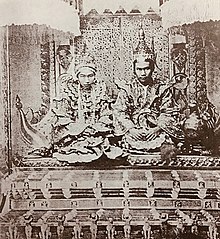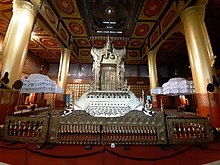

|
m Moving Category:Burmese culturetoCategory:Culture of Myanmar per Wikipedia:Categories for discussion/Speedy
|
|||
| (25 intermediate revisions by 15 users not shown) | |||
| Line 1: | Line 1: | ||
{{italic title}} |
|||
| ⚫ |
'''''Palin''''' ({{lang-my|ပလ္လင်}}; from {{lang-pi|pallaṅka}}, lit |
||
[[File:Saya Chone's "Royal Audience".png|300px|thumb|Depiction of the Burmese royal throne by a court painter, [[Saya Chone]].]] |
|||
| ⚫ | '''''Palin''''' ({{lang-my|ပလ္လင်}}; from {{lang-pi|pallaṅka}}, {{lit|couch}}or'sofa') refers to any one of six types of [[throne]]s recognized in traditional Burmese scholarship. The ''palin'' is an important symbol of the Burmese monarchy and features prominently in Burmese architecture and Burmese Buddhist iconography. The ''palin'' is featured on the seal of Myanmar's [[Ministry of Religious Affairs and Culture (Myanmar)|Ministry of Religious Affairs and Culture]]. |
||
== Types of ''palin'' == |
== Types of ''palin'' == |
||
[[File:The Prime Minister, Shri Narendra Modi calling on the President of Myanmar, Mr. U. Thein Sein, at Nay Pyi Taw, Myanmar on November 11, 2014 (2).jpg|thumb|Former Burmese President [[Thein Sein]] and Indian prime minister [[Narendra Modi]] seated in the backdrop of a ''palin'' in [[Naypyidaw]].]] |
|||
Traditional Burmese scholarship recognizes six types of thrones, namely: |
Traditional Burmese scholarship recognizes six types of thrones, namely: |
||
# |
# {{IAST|Aparājitapallaṅka}} ({{my|အပရာဇိတပလ္လင်}}) – the [[Buddha]]'s throne |
||
# |
# {{IAST|Kamalāsanapallaṅka}} ({{my|ကမလာသနပလ္လင်}}) – [[Brahma]]'s throne |
||
# |
# {{IAST|Dibbāsanapallaṅka}} ({{my|ဒိဗ္ဗာသနပလ္လင်}}) – [[Nat (spirit)|nat]]'s throne |
||
# |
# {{IAST|Rājapallaṅka}} ({{my|ရာဇပလ္လင်}}) – monarch's throne |
||
# |
# {{IAST|Dhammāsanapallaṅka}} ({{my|ဓမ္မာသနပလ္လင်}}) – [[Buddhist monk]]'s throne |
||
# |
# {{IAST|Aṭṭakaraṇapallaṅka}} ({{my|အဋ္ဋကရဏပလ္လင်}}) – [[judge]]'s throne |
||
== Usage by Burmese monarchs == |
== Usage by Burmese monarchs == |
||
[[File: |
[[File:Queen Supayalat and King Thibaw.jpg|thumb|[[King Thibaw]] and Queen [[Supayalat]] seated on [[The Lion Throne of Myanmar|The Lion Throne]] at [[Mandalay Palace]]]] |
||
In pre-colonial times, the |
In pre-colonial times, the {{IAST|rājapallaṅka}} (Burmese ''yazapalin'') seated the sovereign and his chief consort. Traditionally, Burmese palaces possessed eight types of thrones, housed in nine palace halls, leading to the Burmese adage, "eight thrones, nine palace halls" (ပလ္လင်ရှစ်ခန်း ရွှေနန်းကိုးဆောင်).<ref>{{Cite web|url=http://www.moi.gov.mm/npe/?q=news/8/03/2016/id-38407|title=ယဉ်ကျေးမှု ထုံးဓလေ့ဟောင်း တို့နိုင်ငံသားတို့မမေ့ကောင်း|website=Myanmar News Agency}}</ref> |
||
[[File:Lion Throne of Myanmar.jpg|thumb|The [[Lion Throne of Burma|Lion Throne]] from [[Mandalay Palace]] was preserved and is now displayed at the [[National Museum of Myanmar (Yangon)|National Museum of Myanmar]] in Yangon.]] |
|||
| ⚫ | The thrones were carved of wood, specifically by hereditary palace carpenters.<ref name="Thant 1960">{{Cite journal|last=Thant|first=Yi Yi|date=December 1960|title=The Thrones of the Burmese Kings|url=http://www.burmalibrary.org/docs20/Yi_Yi-1960-The_Thrones_of_the_Burmese_Kings-bu-red.pdf|journal=Journal of Burma Research Society|volume=43|pages=97–123}}</ref> An auspicious time was chosen by astrologers to commence operations, and construction of these thrones was heralded by a royal ceremony to propitiate spirits.<ref name="Thant 1960" /> The thrones were simultaneously constructed according to a prescribed list of requirements, coated with resin, and decorated with [[gold leaf]] and [[glass mosaic]].<ref name="Thant 1960" /> |
||
| ⚫ | The most important throne was the "Lion Throne" ({{IAST|Sīhāsanapallaṅka}}), which had a replica in the Hluttaw as well.<ref name="Thant 1960" /> |
||
| ⚫ |
The thrones were carved of wood, specifically by hereditary palace carpenters.<ref name=" |
||
| ⚫ | The thrones used different prescribed motifs and designs, types of wood, and were allocated to specific halls in the royal palace.<ref>{{Cite web|url=http://www.moi.gov.mm/moi:zg/?q=content/%E1%80%95%E1%80%9C%E1%82%85%E1%80%84%E1%80%B9%E1%80%9B%E1%80%BD%E1%80%85%E1%80%B9%E1%80%81%E1%80%94%E1%80%B9%E1%80%B8%E1%81%8A-%E1%80%B1%E1%80%9B%E1%82%8A%E1%80%94%E1%80%94%E1%80%B9%E1%80%B8%E1%80%80%E1%80%AD%E1%80%AF%E1%80%B8%E1%80%B1%E1%80%86%E1%80%AC%E1%80%84%E1%80%B9|title=ပလ္လင်ရှစ်ခန်း၊ ရွှေနန်းကိုးဆောင်|last=Tha|first=Maung|date=2016-11-15|website=Ministry of Information}}</ref> The thrones were also grouped by height, as follows: |
||
| ⚫ |
The most important throne was the "Lion Throne" ( |
||
#{{IAST|Mahāpallaṅka}} (မဟာပလ္လင်) – {{convert|24|ft}} |
|||
| ⚫ |
The thrones used different prescribed motifs and designs, types of wood, and were allocated to specific halls in the royal palace.<ref>{{Cite web|url=http://www.moi.gov.mm/moi:zg/?q=content/%E1%80%95%E1%80%9C%E1%82%85%E1%80%84%E1%80%B9%E1%80%9B%E1%80%BD%E1%80%85%E1%80%B9%E1%80%81%E1%80%94%E1%80%B9%E1%80%B8%E1%81%8A-%E1%80%B1%E1%80%9B%E1%82%8A%E1%80%94%E1%80%94%E1%80%B9%E1%80%B8%E1%80%80%E1%80%AD%E1%80%AF%E1%80%B8%E1%80%B1%E1%80%86%E1%80%AC%E1%80%84%E1%80%B9|title=ပလ္လင်ရှစ်ခန်း၊ ရွှေနန်းကိုးဆောင်|last=Tha|first=Maung|date=2016-11-15|website=Ministry of Information |
||
| ⚫ | #{{IAST|Majjhimapallaṅka}} (မဇ္စျိမပလ္လင်) – {{convert|12|ft}} |
||
| ⚫ | |||
#''Mahāpallaṅka'' (မဟာပလ္လင်) - 16 [[cubit]]s |
|||
| ⚫ | |||
| ⚫ | |||
Below is a list of these eight types of thrones: |
Below is a list of these eight types of thrones: |
||
| Line 31: | Line 34: | ||
!Name (Pali) |
!Name (Pali) |
||
!Name (Burmese) |
!Name (Burmese) |
||
!Primary |
!Primary motif |
||
!Type of |
!Type of wood |
||
!Location(s) in |
!Location(s) in palace |
||
!Photo |
|||
!Prescribed Usages |
|||
|- |
|- |
||
|1 |
|1 |
||
| |
| {{IAST|Sīhāsanapallaṅka}} |
||
|သီဟာသနပလ္လင် |
|သီဟာသနပလ္လင် |
||
|''[[Chinthe]]'' (lion) |
|''[[Chinthe]]'' (lion) |
||
|[[Gmelina arborea |
|''[[Gmelina arborea]]'' |
||
|Royal Audience Hall; |
|Royal Audience Hall; |
||
''[[Hluttaw]]'' |
''[[Hluttaw]]'' |
||
|[[File:Lion throne, Mandalay Palace.jpg|100px]] |
|||
| |
|||
|- |
|- |
||
|2 |
|2 |
||
| {{IAST|Bhamarāsanapallaṅka}} |
|||
|''Bhamayāsanapallaṅka'' |
|||
|ဘမယာသနပလ္လင် |
|ဘမယာသနပလ္လင် |
||
|Bumblebee |
|Bumblebee |
||
|[[Cinnamomum tamala |
|''[[Cinnamomum tamala]]'' |
||
|Glass Palace |
|Glass Palace |
||
|[[File:Bumblebee Throne of Myanmar.jpg|100px]] |
|||
| |
|||
|- |
|- |
||
|3 |
|3 |
||
| {{IAST|Padumāsanapallaṅka}} |
|||
|''Padumasanapallaṅka'' |
|||
|ပဒုမ္မာသနပလ္လင် |
|ပဒုမ္မာသနပလ္လင် |
||
|Lotus |
|Lotus |
||
|[[Jackfruit|''Artocarpus heterophyllus'']] |
|[[Jackfruit|''Artocarpus heterophyllus'']] |
||
|Western Audience Hall |
|Western Audience Hall |
||
|[[File:Lotus Throne of Myanmar.jpg|100px]] |
|||
| |
|||
|- |
|- |
||
|4 |
|4 |
||
| {{IAST|Haṃsāsanapallaṅka}} |
|||
|''Haṃsasanapallaṅka'' |
|||
|ဟံသာသနပလ္လင် |
|ဟံသာသနပလ္လင် |
||
|[[Hamsa (bird)|''Hamsa'' (bird)]] |
|[[Hamsa (bird)|''Hamsa'' (bird)]] |
||
|[[Hopea odorata |
|''[[Hopea odorata]]'' |
||
|Eastern Hall of Victory |
|Eastern Hall of Victory |
||
|[[File:Hamsa Throne of Myanmar.jpg|100px]] |
|||
| |
|||
|- |
|- |
||
|5 |
|5 |
||
| {{IAST|Gajāsanapallaṅka}} |
|||
|''Gajasanapallaṅka'' |
|||
|ဂဇာသနပလ္လင် |
|ဂဇာသနပလ္လင် |
||
|Elephant |
|Elephant |
||
|[[Magnolia champaca |
|''[[Magnolia champaca]]'' |
||
|''[[Byedaik]]'' (Privy Council) |
|''[[Byedaik]]'' (Privy Council) |
||
|[[File:Elephant Throne of Myanmar.jpg|100px]] |
|||
| |
|||
|- |
|- |
||
|6 |
|6 |
||
| {{IAST|Saṅkhāsanapallaṅka}} |
|||
|''Saṅkhasanapallaṅka'' |
|||
|သင်္ခါသနပလ္လင် |
|သင်္ခါသနပလ္လင် |
||
|Conch |
|Conch |
||
|[[Mangifera indica |
|''[[Mangifera indica]]'' |
||
|Regalia Hall |
|Regalia Hall |
||
|[[File:Conch Shell Throne of Myanmar.jpg|100px]] |
|||
| |
|||
|- |
|- |
||
|7 |
|7 |
||
| {{IAST|Migāsanapallaṅka}} |
|||
|''Migasanapallaṅka'' |
|||
|မိဂါသနပလ္လင် |
|မိဂါသနပလ္လင် |
||
|Deer |
|Deer |
||
|[[Ficus racemosa|''Ficus glomerata'']] |
|[[Ficus racemosa|''Ficus glomerata'']] |
||
|Southern Gatehouse Hall |
|Southern Gatehouse Hall |
||
|[[File:Deer Throne of Myanmar.jpg|100px]] |
|||
| |
|||
|- |
|- |
||
|8 |
|8 |
||
| |
| {{IAST|Mayurāsanapallaṅka}} |
||
|မယုရာသနပလ္လင် |
|မယုရာသနပလ္လင် |
||
|Peacock |
|Peacock |
||
|[[Butea monosperma |
|''[[Butea monosperma]]'' |
||
|Northern Gatehouse Hall |
|Northern Gatehouse Hall |
||
|[[File:Peacock Throne of Myanmar.jpg|100px]] |
|||
| |
|||
|} |
|} |
||
| Line 105: | Line 108: | ||
[[File:Botataung Stupa 0308.jpg|thumb|A throne seating an image of the Buddha at [[Botataung Pagoda]].]] |
[[File:Botataung Stupa 0308.jpg|thumb|A throne seating an image of the Buddha at [[Botataung Pagoda]].]] |
||
The ''palin'' is also used to seat images and statues of the Buddha, variously called ''gaw palin'' (ဂေါ့ပလ္လင်), ''phaya palin'' (ဘုရားပလ္လင်) or ''samakhan'' (စမ္မခဏ်), from the Pali term |
The ''palin'' is also used to seat images and statues of the Buddha, variously called ''gaw palin'' (ဂေါ့ပလ္လင်), ''phaya palin'' (ဘုရားပလ္လင်) or ''samakhan'' (စမ္မခဏ်), from the Pali term {{IAST|sammakhaṇḍa}}. This ''palin'' is a feature of many Buddhist household shrines in Burma. |
||
== References == |
== References == |
||
| Line 112: | Line 114: | ||
== See also == |
== See also == |
||
{{Commons}} |
{{Commons category|Thrones of Myanmar}} |
||
* [[Busabok]], the Thai equivalent |
|||
* [[Throne]] |
* [[Throne]] |
||
[[Category: |
[[Category:Culture of Myanmar]] |
||
| ⚫ | |||
[[Category:Burmese monarchy]] |
[[Category:Burmese monarchy]] |
||
| ⚫ | |||
[[Category:Buddhist iconography]] |
|||
[[Category:Thrones]] |
[[Category:Thrones]] |
||

Palin (Burmese: ပလ္လင်; from Pali: pallaṅka, lit. 'couch' or 'sofa') refers to any one of six types of thrones recognized in traditional Burmese scholarship. The palin is an important symbol of the Burmese monarchy and features prominently in Burmese architecture and Burmese Buddhist iconography. The palin is featured on the seal of Myanmar's Ministry of Religious Affairs and Culture.

Traditional Burmese scholarship recognizes six types of thrones, namely:

In pre-colonial times, the rājapallaṅka (Burmese yazapalin) seated the sovereign and his chief consort. Traditionally, Burmese palaces possessed eight types of thrones, housed in nine palace halls, leading to the Burmese adage, "eight thrones, nine palace halls" (ပလ္လင်ရှစ်ခန်း ရွှေနန်းကိုးဆောင်).[1]

The thrones were carved of wood, specifically by hereditary palace carpenters.[2] An auspicious time was chosen by astrologers to commence operations, and construction of these thrones was heralded by a royal ceremony to propitiate spirits.[2] The thrones were simultaneously constructed according to a prescribed list of requirements, coated with resin, and decorated with gold leaf and glass mosaic.[2]
The most important throne was the "Lion Throne" (Sīhāsanapallaṅka), which had a replica in the Hluttaw as well.[2]
The thrones used different prescribed motifs and designs, types of wood, and were allocated to specific halls in the royal palace.[3] The thrones were also grouped by height, as follows:
Below is a list of these eight types of thrones:
| No. | Name (Pali) | Name (Burmese) | Primary motif | Type of wood | Location(s) in palace | Photo |
|---|---|---|---|---|---|---|
| 1 | Sīhāsanapallaṅka | သီဟာသနပလ္လင် | Chinthe (lion) | Gmelina arborea | Royal Audience Hall; | 
|
| 2 | Bhamarāsanapallaṅka | ဘမယာသနပလ္လင် | Bumblebee | Cinnamomum tamala | Glass Palace | 
|
| 3 | Padumāsanapallaṅka | ပဒုမ္မာသနပလ္လင် | Lotus | Artocarpus heterophyllus | Western Audience Hall | 
|
| 4 | Haṃsāsanapallaṅka | ဟံသာသနပလ္လင် | Hamsa (bird) | Hopea odorata | Eastern Hall of Victory | 
|
| 5 | Gajāsanapallaṅka | ဂဇာသနပလ္လင် | Elephant | Magnolia champaca | Byedaik (Privy Council) | 
|
| 6 | Saṅkhāsanapallaṅka | သင်္ခါသနပလ္လင် | Conch | Mangifera indica | Regalia Hall | 
|
| 7 | Migāsanapallaṅka | မိဂါသနပလ္လင် | Deer | Ficus glomerata | Southern Gatehouse Hall | 
|
| 8 | Mayurāsanapallaṅka | မယုရာသနပလ္လင် | Peacock | Butea monosperma | Northern Gatehouse Hall | 
|

The palin is also used to seat images and statues of the Buddha, variously called gaw palin (ဂေါ့ပလ္လင်), phaya palin (ဘုရားပလ္လင်) or samakhan (စမ္မခဏ်), from the Pali term sammakhaṇḍa. This palin is a feature of many Buddhist household shrines in Burma.